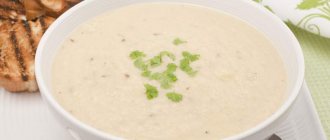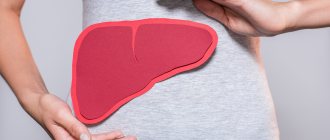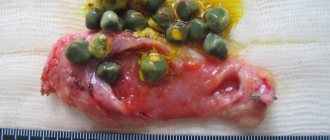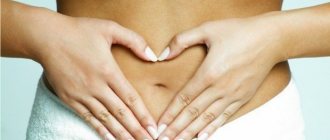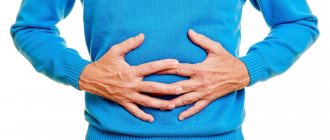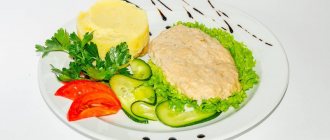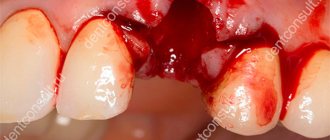Photo: UGC Bile plays a key role in digestion, one of the main functions of the body. Malfunctions in the operation of this system are associated primarily with nutritional disorders . This explains the widespread occurrence of such a phenomenon as bile stagnation - 20% of the population suffers from it. This is more often a problem for older people, but also observed in childhood .
Bile in the stomach (duodenogastric reflux)
Duodenogastric reflux is the reflux of the contents of the duodenum into the stomach cavity. Normally, after a certain period of time after food enters the stomach, a portion of bile is released into the lumen of the duodenum, aimed at further, more thorough digestion of the food bolus. The presence of bile creates an alkaline environment in the cavity of the duodenum. At the border of the stomach and duodenum there is a pyloric sphincter, which prevents the movement of food in the opposite direction and separates the acidic environment of the stomach from the alkaline environment of the duodenum. If the function of the sphincter is impaired, for example, if it is not fully closed, the alkaline contents of the duodenum enter the stomach. Burning has an irritating effect on the gastric mucosa, which, when exposed to it regularly, causes a chronic inflammatory process called reflux gastritis.
Top 15 foods to improve bile flow
Chicken
Steamed, baked or boiled fillets contain lean protein. Dietary protein is valuable because it stimulates the secretion of the hormone cholecystokinin (CCK). It causes contraction of the gallbladder and secretion of pancreatic enzymes.
Radish
Contains sulfur, which helps remove deposits from the gallbladder, and vitamin C to prevent further formation. The composition also contains the enzyme cholesterol-7-alpha-hydroxylase, which reduces cholesterol and triglyceride levels. Despite the benefits, radishes are not recommended for everyone and you should consult your doctor before consuming them. [6]
Broccoli
Cabbage is rich in fiber and calcium, which are essential for gastrointestinal health. Dietary fiber improves peristalsis, microflora, and reduces bile production, which is important when it stagnates. [7]
Coffee
Studies have found that caffeine suppresses the crystallization of cholesterol and increases the outflow of fluid from the gallbladder. However, decaffeinated coffee does not have such effects. [8]
Turmeric
The bright orange spice reduces symptoms of bloating and gas due to indigestion, and has choleretic properties (especially when combined with black pepper). Turmeric, although it improves lipid metabolism, is not recommended for gallstone disease. [9]
Sweet red and green peppers
Bell peppers are the best source of vitamin C among vegetables. It also replenishes B vitamins, magnesium, folic acid and phytonutrients to protect the gastrointestinal tract from many diseases. [10]
Milk thistle
The herb is involved in the formation of enzymes, increases bile production, soothes mucous membranes and reduces inflammation. However, milk thistle is not recommended for Gilbert's syndrome - it accelerates the first phase of detoxification, thereby increasing the level of bilirubin in the blood.
Oranges
The pulp is rich in vitamin C, due to the lack of which gallstone disease develops. This is confirmed by doctors and a year-long study involving 2,129 people. Since taking vitamin C supplements increases the risk of kidney stones, it's best to get the vitamin from natural foods such as oranges and other citrus fruits. [eleven]
Tomatoes
Tomato fruits stimulate bile flow and remove toxins through the digestive tract, and also reduce inflammation. Tomato juice without sweeteners has the same properties.
Salo
The product contains 40% unsaturated fatty acids and is rich in fat-soluble vitamins A, D, E. Therefore, lard binds and removes toxins, and has choleretic properties.
Low-fat dairy products
Low-fat milk, cheese, kefir, yogurt, and yogurt do not burden the gastrointestinal tract, do not delay gastric emptying, and do not cause bloating. Additionally, fermented milk products contain the necessary pre- and probiotics.
Legumes
Beans, soybeans, and lentils are rich in vegetable protein. For problems with gallstones, it is healthier than animals, which is confirmed by research. [12]
Flax-seed
Flaxseed oil reduces pain and has an anti-inflammatory effect. But it cannot be taken for acute pancreatitis (only during remission), since the additional secretion of bile provokes spasms.
Nuts.
Some studies have shown that almonds and walnuts prevent the formation of gallstones. Due to their high fat content, it is important to eat them in small quantities.
Tofu
100 g of vegetarian cheese contains 345 mg of calcium, 8-13 g of protein and only 5-10 g of fat. The dietary product will help avoid attacks of pain in the right hypochondrium, diversify the menu and prevent blockage of the bile ducts.
Other ways to normalize bile flow
The worst enemy of the gallbladder is low-calorie diets and losing weight by 1–1.5 kg per week. They increase the risk of stone formation and other diseases, since when food consumption is reduced, the need for bile decreases - the secretion becomes thick and concentrated. To help your body, you need to follow other rules:
- eat fractionally by the hour - 5-6 times a day at the same time;
- there is a lot of thermally processed and raw fiber; [13]
- avoid fatty foods and consume 20–40 g of fat per day;
- exclude from the diet everything fried, crusty foods and refined carbohydrates - added sugars, sweeteners, white flour, instant cereals, baked goods, desserts;
- give up alcohol;
- do not consume ice cream, cold foods and drinks - the cold blocks the functioning of the organ;
- exclude canned vegetables and fruits from the menu;
- drink 2–2.5 liters of clean water between meals;
- do not get carried away with ginger, as it stimulates the liver to secrete more bile juice, but does not accelerate its release; [14]
- maintain a moderate level of activity - tiring exercise forces the liver to produce bile more actively, but does not improve its outflow. [15]
Expert commentary
Tatyana Eliseeva, nutritionist, nutritionist
Research confirms that bitter foods and bitter herbs—dark green leafy vegetables, beets, artichokes, dandelion root tea, celery juice—help relieve bile flow problems. Discoveries on this matter continue. So in 2021, it was documented that bile acids are produced by microbes in the intestines. This once again confirms that it is necessary to take care of the gastrointestinal tract as a whole, and not about individual organs.
Information sources
- Physiology, Bile Secretion, https://www.ncbi.nlm.nih.gov/books/NBK470209/
- Epidemiology of Gallbladder Disease: Cholelithiasis and Cancer, https://www.ncbi.nlm.nih.gov/pmc/articles/PMC3343155/
- Biliary Obstruction, https://www.ncbi.nlm.nih.gov/books/NBK539698/
- Dietary Patterns and Risk of Gallbladder Disease: A Hospital-based Case-Control Study in Adult Women, https://www.ncbi.nlm.nih.gov/pmc/articles/PMC4438647/
- Bile Formation and Secretion, https://www.ncbi.nlm.nih.gov/pmc/articles/PMC4091928/
- Deciphering the Nutraceutical Potential of Raphanus sativus—A Comprehensive Overview, https://www.ncbi.nlm.nih.gov/pmc/articles/PMC6412475/
- Side Streams of Broccoli Leaves: A Climate Smart and Healthy Food Ingredient, https://www.ncbi.nlm.nih.gov/pmc/articles/PMC7178181/
- Coffee Consumption and Risk of Biliary Tract Cancers and Liver Cancer: A Dose–Response Meta-Analysis of Prospective Cohort Studies, https://www.ncbi.nlm.nih.gov/pmc/articles/PMC5622710/
- Effect of black pepper and piperine on bile secretion and composition in rats, https://pubmed.ncbi.nlm.nih.gov/3431580/
- Serum ascorbic acid and other correlates of gallbladder disease among US adults, https://www.ncbi.nlm.nih.gov/pmc/articles/PMC1508320/
- The effect of vitamin C in high doses on plasma and biliary lipid composition in patients with cholesterol gallstones: prolongation of the nucleation time, https://pubmed.ncbi.nlm.nih.gov/9179545/
- Effect of dietary animal and vegetable protein on gallstone formation and biliary constituents in the hamster, https://pubmed.ncbi.nlm.nih.gov/6708746/
- Fruits and vegetables consumption and the risk of gallstone diasease, https://www.ncbi.nlm.nih.gov/pmc/articles/PMC6641782/
- The Effects of Ginger on Gallbladder Motility in Healthy Male Humans, https://www.ncbi.nlm.nih.gov/pmc/articles/PMC3228982/
- Physical Activity Modulating Lipid Metabolism in Gallbladder Diseases, https://www.ncbi.nlm.nih.gov/pmc/articles/PMC8114792/
Material publication date – October 20, 2021
Attention! The information is for informational purposes only and is not intended to make a diagnosis or prescribe treatment. Always consult a specialized doctor!
Authors: Anna Shelestun, Tatyana Eliseeva Ask a question
Rating:
10
/10
Votes: 3
Usefulness of material 10
Reliability of information 10
Formatting of Article 10
Treatment
Treatment should be comprehensive and include measures to normalize lifestyle, diet and diet, as well as drug therapy. If possible, eliminate physical and emotional stress that negatively affects the motility of the gastrointestinal tract. Long breaks in meals, consumption of fatty, extractive foods, marinades, smoked meats, and coffee are unacceptable. Avoid smoking, drinking alcohol and carbonated drinks. Drug therapy is selected by a gastroenterologist depending on the severity of symptoms and examination results.
Duodenogastric reflux, or the reflux of duodenal contents back into the stomach, is an extremely common digestive disorder. The symptoms that indicate this pathology are subjectively interpreted by many as “heartburn” or “indigestion,” which indicates their low specificity. An accurate diagnosis can only be made by a specialist after a thorough examination. If you experience discomfort associated with eating, we recommend that you contact Professor Gorbakov’s Clinic for specialized help.
Normally, food enters the oral cavity, moves down the esophagus into the stomach, and then enters the duodenum. Here it mixes with bile, which ensures the emulsification (breakdown) of fats and the absorption of most of the nutrients. The unilateral evacuation of food into the duodenum is supported by the reflexive opening and closing of the pyloric sphincter (pylorus). It also prevents retrograde (backward) flow of the bolus.
Improper functioning of the sphincter (its insufficient locking), as well as hypertension in the duodenum associated with chronic duodenitis, can cause bile to flow back into the stomach - duodenogastric reflux.
Often this disorder provokes the presence of inflammatory processes in the stomach (gastritis), duodenum (duodenitis), gallbladder (cholecystitis, biliary dyskinesia), pancreas (pancreatitis), and surgical interventions, namely:
- cholecystectomy;
- gastric resection;
- vagotomy;
- gastroenterostomy;
- enterostomy.
Causes of bile stagnation
Cholestasis can develop for many reasons, the most common of which are:
- obstruction of the gallbladder or bile ducts due to the presence of stones in them, as well as when they are compressed by a cyst or tumors;
- abnormalities in the structure of the gallbladder or ducts, when they are bent;
- inflammation of the gallbladder or ducts;
- dysfunction of the valves responsible for the free movement of bile;
- endocrine and enzymatic disorders, in which thickening of bile and changes in its chemical properties are observed.
Diagnosis
Stagnation of bile is characterized by changes in the color of the sclera and skin (yellowing), as well as complaints of itching, unstable stools (alternating constipation and diarrhea), discolored feces and dark urine. If there are even several of these symptoms, the doctor has reason to prescribe a biochemical blood test (the level of bilirubin, bile acids, liver enzymes, etc. is examined), a urine test for urobilin, ultrasound of the liver and gallbladder, fibrogastroduodenoscopy, etc. When diagnosing cholestasis, it is important to distinguish between these condition from viral, parasitic and other liver diseases that have a similar clinical picture.
Symptoms of GERD
Stomach acid can enter the respiratory tract
Acid from the stomach can enter the respiratory tract (this usually happens when lying down) and cause a sore throat, hoarseness, dry mouth, and cough. GERD can stimulate the development of bronchial asthma, chronic obstructive bronchitis, and aspiration pneumonia.
The constant presence of acidic contents in the esophagus leads to scarring of the mucous membrane of the lower part of the esophagus, as a result of which the lumen of the esophagus narrows (this complication of GERD is called peptic stricture of the esophagus). In this case, pain when swallowing and dysphagia (difficulty swallowing) may occur.
But first of all, GERD is characterized by symptoms that usually appear an hour and a half after eating. This:
Heartburn
Heartburn is the main symptom of GERD. The presence of heartburn that regularly occurs after eating is the basis for diagnosing the disease.
More about the symptom
Belching
With GERD, belching after eating is typical.
More about the symptom
Sour or bitter taste in the mouth
A sour taste in the mouth means that acid from the stomach has traveled up the esophagus and irritated the taste buds. The taste in the mouth may be bitter if bile enters the esophagus, which normally should not rise above the duodenum.
Chest pain
A burning sensation may be felt behind the sternum (along the esophagus). Often the complaint is formulated as chest pain, so it is important to make sure that the pain is caused by irritation of the esophageal mucosa, and not by heart problems. In the case of GERD, the pain is usually associated with food intake, begins in the epigastric region and only then rises higher. Pain can radiate to the neck, shoulders, interscapular area, and lower jaw.
Causes of the disease and its varieties
Experts call the following main prerequisites for the occurrence of sludge syndrome. First of all, this is:
- Impaired motility of the gallbladder.
- Changes in bile lithogenicity, heterogeneity in the gallbladder.
- Inflammation of the walls of the gallbladder.
There are 3 types of BS:
- Microlithiasis is a suspension of hyperechoic microparticles, from single to multiple.
- Putty-like bile clots are heterogeneous bile with clots of varying densities.
- Mixed type, i.e. a combination of putty-like bile with microliths.
If we talk about the types of pathology, then we are talking about:
- primary sludge is a syndrome that occurs as an independent disease, there is no connection with another pathology;
- Secondary BS occurs against the background of concomitant pathology, and it is very diverse, ranging from blood diseases to metabolic disorders.
Experienced therapists consider risk factors for the disease to be:
- gender, often female;
- heredity;
- obesity;
- sedentary lifestyle;
- nature of nutrition;
- age;
- alcohol abuse.
